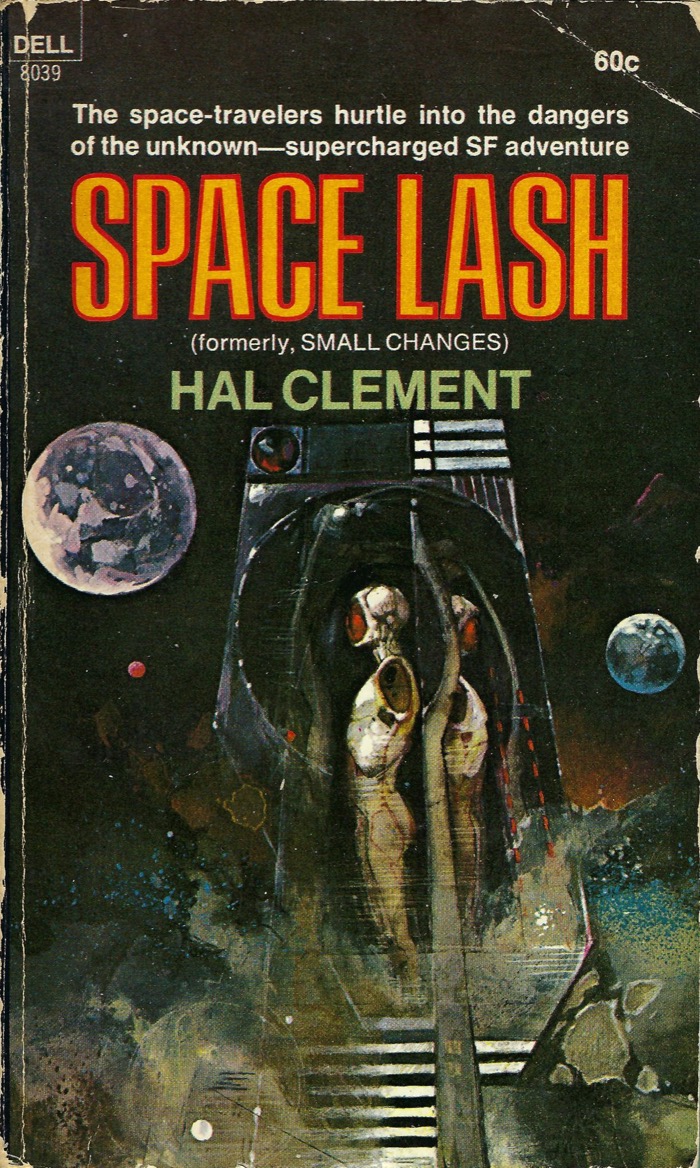Space Lash
Reviewed date: 2025 Sep 5
206 pages
Formerly published as Small Changes
I very much enjoyed "Trojan Fall". Stories that rely on hard scientific knowledge are fun. The best story in the collection is Raindrop.
Dust Rag
Two astronauts on the moon take an exploratory walk in a crater, and due to particular magnetic effects triggered by a solar storm they find themselves in a fine cloud of suspended moon dust. It's amusing until the charged dust particles adhere to their visors and block their vision, at which point finding a way to reverse the static charge and clear their vision is a matter of life and death.
Sun Spot
A crew of scientists burrowed into the inside of a comet make a brave transit around the sun to get a close-up look at the sun. When unforeseen trouble with their equipment threatens to render their main camera system useless, "Grumpy" Ries takes a crew to the comet's surface and makes repairs, risking his life for science.
Uncommon Sense
Laird Cunningham has deliberately crashed his ship and run off into the hostile, airless landscape to escape from the mutinous crew who would kill him to steal the ship for themselves. It's only a matter of time--a day or two--before they fix the ship, and Cunningham can't survive on an airless planet, so he must figure out a way to distract the others so he can retake the ship. Meanwhile, he sits in a cave and watches the bizarre local life forms: crab-like creatures with liquid metal blood that feed on what serves for local "plant" growth, and large, aggressive centipede-like predators that feed upon the crabs. If only there were a way to use these creatures to his advantage…
"Trojan Fall"
La Roque has made his big score, now he must get away with it. He is no pilot or spaceman, but he buys a spaceship and heads for the stars, deducing that if he can evade immediate capture then he can make a clean break. With the law hot on his tail, La Roque finds a pair of red dwarf stars, sets his spaceship into the Trojan point between them, turns off all power, and waits for his pursuers to give up and leave. Too late he realizes that his ship has not stayed in the stable Trojan point, but has been drawn into one of the stars. The view shifts to the watching crew on the enforcement cruiser, one of whom remarks that if La Roque had known his science, he would have known that stable Trojan points only exist between objects of vastly differing masses; there is no stable Trojan point between two stars of roughly equal mass.
Fireproof
A saboteur breaks into a space station to destroy it and its nuclear deterrent. He releases fuel into the zero-G confines of the space station and attempts to light it with an incendiary bomb, but in zero-G the floating globs of fuel will not sustainably burn because the globe of flame smothers itself out.
Halo
A superintendent checks on a student's progress. The student has made a real hash of things at the farm, leading to the complete destruction of one plot, and a runaway growth of strange chemicals at the third plot. It's the solar system. The "plots" are planets, the runaway growth on the third plot is all the life on Earth, and these aliens seem to be living comets that farm and eat hydrocarbons.
The Foundling Stars
Elven Toner and Dick Ledermann arrange a fantastic experiment to test their two competing hypotheses regarding star formation, which Toner in particular thinks cannot statistically happen by natural processes without some external impetus. The experiment fails in an unexpected way, and the viewpoint shifts to two "soldiers" (each being mostly incorporeal and several hundred astronomical units large) who are sweeping up interstellar detritus to form stars as part of a galactic war effort. It's them who are providing the needed impetus for star formation.
Raindrop
The Raindrop is an experiment in orbit around Earth. It's a huge volume of water, melted from several comets, encased in a tough plastic skin, and seeded with life forms. The hard radiation of space causes a rapid mutation rate, and the eventual hope is to develop edible life forms that can be farmed and help feed Earth's rapidly growing population.
Silbert is the caretaker of Raindrop, and he's visited by Aino and Brenda Weisanen, a couple who represent major new shareholders of the recently-privatized corporation that owns Raindrop. The Weisanens intend to turn Raindrop into a private home for people like themselves: genetically modified humans who (among other things) can only successfully carry their babies to term in zero-G. Silbert and Bresnahan realize that Raindrop is the hope for billions of people on Earth, and if the Weisanens snatch that hope away by ending the farm experiment, it will cause chaos. But how to convince them to cooperate and come to an agreement that will benefit all of humanity, not just the few hundred genetically modified people who will live in space?
The Mechanic
On a high-speed hydrofoil, our heroes hunt down sick wildlife and treat it. Or rather, not wildlife, but pseudo-life. It's never explained, but the seas are populated by self-reproducing robotic versions of aquatic life, which suffer from various diseases that threaten the new cyborg ecosystem. One of those pathogens attacks the ship, damaging one of the hydrofoils and causing a crash at sea, which injures everyone on board. The rest of the story is about medical technology: they have the ability to use gene sequences and big fancy machines to fix injuries and regrow missing body parts, one cell at a time. One character gets a new face and has a severed hand re-attached and fixed up. It's all bizarre and none of the story hangs together well. This one is disappointing.
